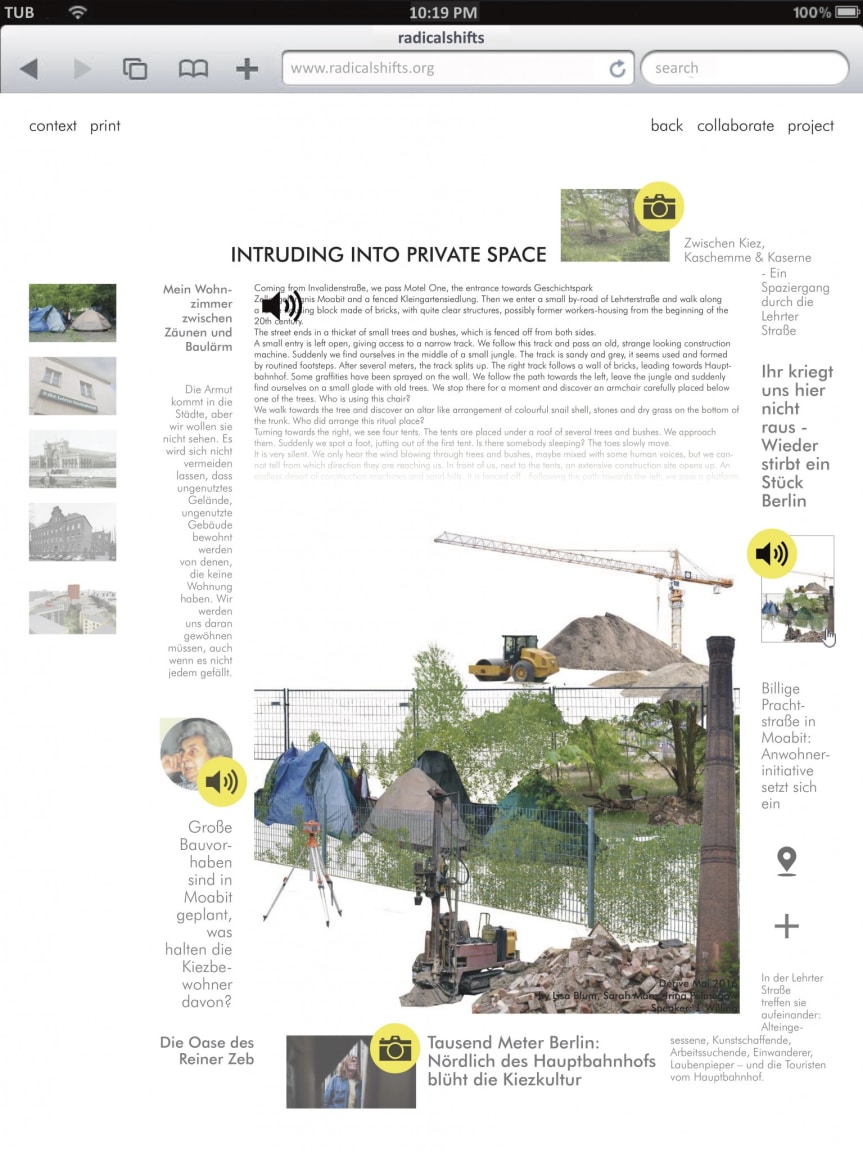RADICAL SHIFTS (2016) – Lisa Blum, Sarah Manz, Irina Pelmegow
RESEARCH STATEMENT
“We prefer a world that can be modified progressively, against a background of valued remains, a world in which one can leave a personal mark alongside the marks of history” (Lynch 1976)1
RADICAL SHIFTS is an approach to capture physical and so- cial transformation processes in cities by telling the stories of those, who shape and inhabit the urban space – the dwellers, occupants, users.
Change is an inherent component of cities, constantly re-forming the cityscape and, therefore, our daily habitat. It can be protracted with great effort, but not stopped by any means. However, established preservation practices attempt to conserve specific conditions and seek to reanimating most valuable layers of history. Based on Kevin Lynch’s text The Presence of the Past in his book What Time is this Place from 1976, we question this established conservation practice
by suggesting an alternative approach to urban heritage, a heritage that is ephemeral and unexceptional.
The spatial and the social environment is constantly affected by change. Shifting social, political and economic structures and negotiation processes on local, regional and global level have a large impact on the creation and use of space. Therefore, RADICAL SHIFTS is an attempt to reveal, collect and document changes occurring in the urban realm, in or- der to preserve those contemporary narratives for the future. Referring to Kevin Lynch’s ‘environmental archive’ (Lynch 1976)2, RADICAL SHIFTS is a site-specific archive of places unveiling their spatial and social “layers” of different time periods. Every space represented in the archive can be rec- ognized as a “box”, filled with narratives on their spatial and social shifts in the past, their present state and their future development. Those narratives stimulate our reflection on the past and the present and will be witnessing from our present for our children, grandchildren and our great-grandchildren, as “saving the past can be a way of learning for the future” (Lynch 1976)3.








THE METHOD
Shifts become most apparent within the tangible, the built environment, while shifts in the intangible, the social environ- ment, remain mostly hidden on the first sight. During several derivés through Moabit, we recognized places where trans- formation processes are happening at the very moment, con- struction sites and new developments next to remains from the past. But the more we became occupied with a place in transformation, the more intangible layers, people and their stories, we detected.
Having in mind Kevin Lynch ́s categorisation of time periods – the remote past – the immediate past – the present and the future – we started to explore and document those places in their present state. But almost simultaneously, we revealed former time periods and their remainings and learned about the sites expected development.
THE ARCHIVE
The structure and design for an RADICAL SHIFTS archive aims to shed a different light on heritage by emphasizing the elusive instead of the consistent in the urban realm. The complexity of shifts, their catalytic forces and their impact on the physical and social environment are reflected in the way
the narratives are chosen, edited and structured.
The different narratives, photo series, interviews and field re- ports, provide a sensitive approach to the objective of spatial and social transformation and a different way of engaging with cities. Although the narratives are presenting quite sub- jective perspectives to the reader, they leave space for own interpretation, reflection and exploration.
The way how the digital archive is structured and how the user is leaded through the platform mirrors the serendipitous experience of exploring a space. Playfully and intuitively the user gets the possibility to create it’s own links between the given sources. In addition, for each shift there is limited back- ground information in form of newspaper articles provided, contextualising the broader context in which a site-specific transformation is embedded in.
For further reading and collecting offline, the platform also offers to print the narratives.
The archive is structured as a constantly growing collection
of shifts. The authors curation based on certain principles is an important aspect of the RADICAL SHIFTS platform, while users are invited to contribute their narratives and shifts to the archive. A plus buttons and a “collaborate” category in the main menu indicate possibilities for collaboration.
As transformation processes are inherent components of cities, the digital archive is variable and expandable to other cities in the world, Dar es Salaam being one example. The advantages of such comparative effort is the immediateness and un-hierarchical coexistence of places. However, in order to be able to compare cities of different geographic demo- graphic, political and economic contexts, a greater extent of site-specific background information has to be provided for the user.
___________________________
1 Lynch, Kevin (1976): The presence of the past. In: What Time is this Place? (p. 29-64). Cambridge, MIT Press. p. 39
2 ibid. p. 49
3 ibid. p. 43

